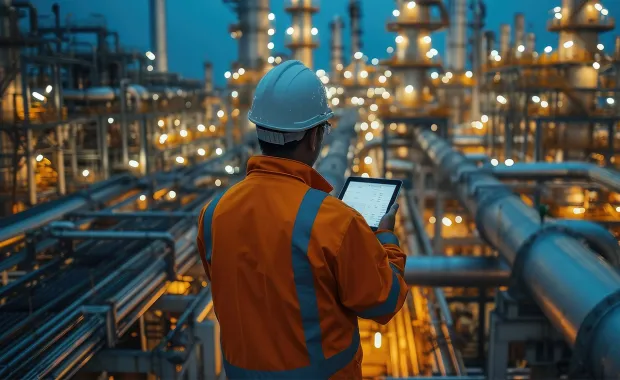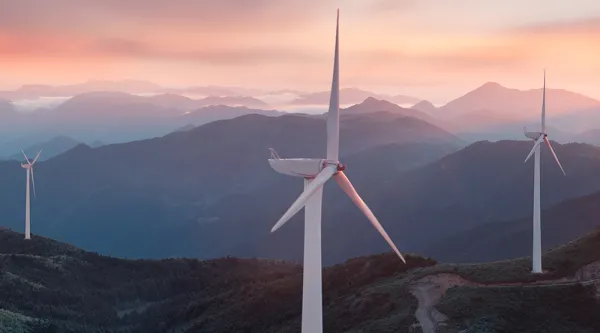CGI’s annual Voice of Our Clients (VOC) global research gathers insights from both existing and potential clients, revealing key priorities for executives across industries. In the latest episode of our Energy Transition Talks series, Peter Warren sits down with the first instalment of a two-part conversation with Helena Jochberger to discuss the overlapping areas of focus revealed by data for both the Energy & Utilities and Manufacturing industries.
The Energy and Utilities framework—specifically in the upstream, midstream and downstream segments of oil and gas—often includes the chemical industry. However, Peter shares, CGI classifies it as part of Manufacturing, due to its process-driven nature.
Helena agrees, highlighting that in the chemical sector, where various recipes and ingredients are involved, effective Manufacturing Execution Systems are essential for managing complex processes that rely on numerous formulas. In the Manufacturing sector, she says, it's important to distinguish between two terms:
-
Discrete manufacturing: Involves producing physical products that require energy.
-
Process industry: Comprises energy-intensive sectors like metals, mining, and chemicals.
Focus on sustainability: Climate change impact on industries
One significant insight from the CGI 2024 Voice of Clients (VOC) report Peter highlights is that, like Energy & Utilities, industries such as metals, mining and pulp and paper are notably prioritizing energy transition, climate change and sustainability initiatives.
This year, 87% of Energy & Utilities executives cite climate change as a high-impact macro trend shaping their organization.
Specifically, the mining industry has a particularly high impact rate at 89% and the pulp and paper sector follows closely at 80%. Peter notes that the pulp and paper industry historically uses biofuels like black liquor for energy, showing a commitment to decarbonization despite ongoing climate challenges.
Aviation innovations: Hybrid solutions, technological advances and design implications
In aviation, Helena notes a major shift as companies create Sustainable Aviation Fuel (SAF) from used cooking oil, known as “fry to fly,” which lowers CO2 emissions compared to traditional kerosene. Looking ahead, Airbus aims to introduce hydrogen-powered flights by 2035, signaling a move toward zero-emission technologies.
Currently, the industry is in a transitional phase where conventional fuels are used alongside innovative options. Electric aircrafts are already flying in areas like Western Canada, proving the viability of battery-powered aviation, though long-haul flights may still depend on biofuels or mixed fuel types as technology progresses.
In aerospace manufacturing, adapting to hydrogen propulsion will require significant research and development, fundamentally changing aircraft design and our understanding of their role in air travel. The transition to hydrogen will necessitate alterations in aircraft structure due to hydrogen's volume needs.
While initial predictions for the hydrogen market varied widely—from $11.7 trillion to $1.9 trillion—advancements are occurring in transportation, such as Kansas City Pacific Rail's hydrogen locomotives and Poland's conversion of over a thousand buses to hydrogen.
The challenge of establishing infrastructure for hydrogen and electric vehicles
Hydrogen infrastructure development faces a catch-22: vehicle manufacturers won’t produce hydrogen-powered vehicles without established fueling stations, and station operators won’t invest until there’s enough vehicle demand. However, some manufacturers are proactively installing hydrogen stations, like those between Edmonton and Calgary in Canada.
The automotive industry is rapidly shifting to electrification, with projections that by 2030, 64% of cars sold in Europe and at least 50% in the U.S. will be electric. This growth requires extensive charging infrastructure, estimating the need for roughly 15,000 public charging stations weekly.
Successful electric vehicle (EV) deployment depends on collaboration across sectors. Key considerations include renewable energy sourcing, charging station development and payment technology integration.
Elon Musk’s success in the EV market illustrates a "chicken or egg" dilemma, Peter says. Initially criticized for lacking a charging network to sell EVs, he established Tesla's Supercharger network. Now, Ford and other organizations enable their vehicles to use Tesla's network seamlessly, with Musk's innovations competing against various charging networks and utilities.
Insights-led decision-making: Data quality, agile organizations and collaboration are key
In the energy sector, companies are reassessing their data strategies to ensure accurate, timely information to drive innovation. There is a now a strong focus on making data-driven decisions, highlighting the interdependence between quality data and actionable insights.
Peter and Helena discuss key macro trends from the 2024 VOC, with both prioritizing the fight against climate change (rated highly by Energy & Utilities executives due its impact on other industries). Technology and digital acceleration are also vital, though there's a clear divide between organizations that are successfully adapting and those that struggle, often due to a lack of agility.
A key factor for success, Peter and Helena agree, is the integration and collaboration between IT departments and business units. When these groups work in silos, outcomes tend to fall short of expectations. Peter emphasizes the need for open communication, teamwork and the establishment of common KPIs to ensure collective progress rather than assigning blame.
Forging ahead: The human element underpinning digital and infrastructure transformation
The transition to hybrid energy solutions is not just about technology; it involves a comprehensive transformation across various industries. The future success of this shift will depend on robust infrastructure development and collaboration among manufacturers, energy providers and service industries. Within this landscape, Helena underscores the importance of prioritizing the human element in any transformation efforts.
Stay tuned for part two of the conversation, which focuses on supply chains and ecosystems.
Listen to other podcasts in this series to learn more about the energy transition
Read the transcript:
- 1. Introduction: Overlapping priorities for Energy & Utilities and Manufacturing
-
Peter Warren
Hello everyone and welcome back for another installment in our Energy and Utilities journey podcasts where we explore the impact of Energy and Utilities and the overlap with other industries. Today we're exploring the intersection between Energy and Utilities and Manufacturing. I have the pleasure of having Helena Jochberger as my guest and my counterpart for Manufacturing. Helena, do you want to introduce yourself?
Helena Jochberger
Sure, thanks for inviting me, Peter. Again, it's always a pleasure to talk to the very adjacent industries like yours, Energy and Utilities. Helena Jochberger is my name. I'm Peter Warren's counterpart for CGI working as Global Industry Lead for Manufacturing. And in this industry, of course, we have a lot of, I would say, overlapping topics to discuss.
- 2. Energy and Manufacturing: A converging focus on climate and innovation
-
Peter Warren
Thank you. It is true. For those that don't know, each year CGI runs a survey of both our clients and other folks who are not our clients, maybe new customers or emerging players, called the Voice of Our Clients global research. One of the catalysts for this conversation was when we were looking at some of the numbers for this year, it was very interesting to see the alignment of concerns between Manufacturing overall and between Energy and Ttilities overall as a great gel. Helena, any comments on that or do you want to kick off the conversation?
Helena Jochberger
Absolutely, I think in Manufacturing we have to differentiate first of all a little bit of terminology: discrete Manufacturing, referring to all physical products that are being produced where energy of course is needed. And then we have the process industry, so the really energy consuming industry like metals and mining, chemical industry and such. We clearly see also in our Voice of Our Clients data that especially the metals and mining or also the pulp and paper industry have a very, very strong focus on energy transition, climate and sustainability aspects.
Peter Warren
Yeah, it's very true. In fact, in the model for Energy and Utilities, if you looked at the upstream, midstream, downstream for oil and gas, example, the chemical industry is considered part of it. But as far as we are in CGI, we treat that as a Manufacturing because it's much more of a Manufacturing process, isn't it?
Helena Jochberger
Absolutely. I mean, all the technological topics like Manufacturing execution systems apply even more so to the process industry. Think of the chemical industry with all the different recipes and ingredients that you need. And of course, you need proper Manufacturing execution systems to make that happen. So a chemical process with a lot of formulas included.
- 3. Hybrid solutions in motion: The evolution of sustainable practices across industries
-
Peter Warren
You talked about the mining industry and everything, and the pulp and paper. So overall, 72 % of our clients this year commented that climate change is impacting them. But specifically, the mining industry was really high. It was 89 % and pulp and paper right behind it at 80%. Those two industries have struggled. The pulp and paper industry, though, even has a history of using something like black liquor, they called it, but it's actually a biofuel to power them. So, they've got a good history of decarbonizing themselves, but there's this impact in all those things. How do you see our side of the industry impacting those types of industries to improve?
Helena Jochberger
I’ll directly hop into a discrete manufacturer if you allow me so because especially in aviation, we can see that this is really impacting us truly. So at the moment we are really witnessing in the aerospace industry, aviation industry the so -called I would say hybrid life of things. Usually, airplanes used to fly on kerosene and they still continue to do so however aerospace companies have developed in the last couple of years the so -called SAF, Sustainable Aviation Fuel. It's basically the oiled oil from the French fries that they are flying on. So it's that quote, fry to fly.
Nonetheless, we know it's lesser CO2 emissions that are emitted throughout that process. However, this will be a continuous improvement until we reach, I would say, the complete zero. a propulsion of complete zero energy form. I mean, that leads us directly also into the topic of hydrogen, would say, since especially when we look at announcements like Airbus, they said they have this so -called zero program where they have committed to have the first hydrogen flight ready by 2035. So I think we need to live a little bit more with that hybrid world. What is your idea on that? Or do you see that in other industries as well?
Peter Warren
No, fully agree with you on that. And I think we used to live in a world of absolutes. If you wanted to fly a plane, you had to do it on kerosene, to your point. Now we see planes flying electrically. It's been happening for multiple years in Western Canada, for example, the sea planes that move between the islands there. And there's other parts of the world that are using battery powered aircraft and very successful. There's new aircraft coming on the market that are electrified.
The use of hydrogen ammonia or even blends is a big thing that's moving forward. And I think in the prep of this call, you and I were talking about the fact that it really depends on how far you're going and what you're trying to get done. you know, the really long haul flights may be using some sort of biofuel in the future that maybe was made on prem at an airport. But it still may contain some element of another carbon fuel for the foreseeable future. But maybe with technology that might change tomorrow too.
Helena Jochberger
Yeah, definitely. I think when we look especially in Manufacturing, of the core value chain aspects is the research and the development. once we are going towards hydrogen flights, of course, this will impact truly the design of an aircraft, the entire design, because the volume is a different one. So it will shape and it will change significantly the way we fly and the way we perceive aircrafts themselves as products..
- 4. Hydrogen hurdles: Navigating the future of energy and infrastructure
-
Peter Warren
And I think that's the thing that's really happening here. There was actually a prediction that the hydrogen market a few years ago was going to be something in the neighborhood of 11 .7 trillion. I think that's the number that was published. And they've republished it down to a mere 1 .9 trillion of new energy stuff. Now there's those that say, told you it wasn't going to work.
That was when people said hydrogen was going to replace everything. And it was never going to be practical that every car and every truck and every train and every plane would be running on hydrogen. But there is enough of that moving forward. And we know that in the transport industry, think Kansas City Pacific Rail here in Canada and the United States is, I think, out hydrogen locomotives coming up, over a thousand buses are being converted in Poland right now to hydrogen. So it's happening in regions, but it's really not this everybody's going to do the same thing point.
The intersection with Manufacturing, we see a lot of manufacturers—we've talked about this in the last one—entering into this industry saying, hey, I know how to make hydrogen well, I'm going to team up even with maybe another large energy company and we're going to start to move forward. Yet other geographies are in this catch -22. The vehicle manufacturers say, can make a hydrogen -powered vehicle. The people that maybe manage all of the truck stops across the United States are saying, yeah, but until you buy the vehicles, I'm not going to put in the charging stations. And the people buying the trucks say, well, I'm not going to buy the trucks until the charging stations are in. So there's this cause and effect, do well. So the paralysis changes by the world, at the same time, we have a manufacturer in Canada, makes hydrogen, putting in hydrogen fueling stations between Edmonton and Calgary. So how do you see this impacting all of the different parts of your industry, like the ability to make energy on -prem and the democratization of energy? How do you see that impacting you guys moving forward?
- 5. The electric road ahead: Balancing vehicle production and charging solutions
-
Helena Jochberger
I think that's an interesting segue also to the automotive industry, which is part of Manufacturing as we know it. And especially you touched upon the infrastructure development side of the story because everybody is running towards electrification, right? And when we see towards 2030, it is estimated that 64 % of all sold cars will be electrical cars in Europe and at least 50 % of the US.
But at the same time, we are producing and selling at large scales this quantity of vehicles, we need of course to have the charging infrastructure in place. there's another interesting quote that there will be needed 15 ,000 public charges per week. So this is a trend rolled out and to be in place per week. So that means you need to have your industry. So where are we going to take our renewable and sober energy from A. B, who is going to develop, to manufacture and to maintain all of these stations. That's again my industry. Then we have banking coming into the picture about what's the right payment, payment methods, payment technology. And last but not least, the cell, let's say technology development has evolved so far that we have everywhere supercharges, you need to rest for a while at these stations. So retail is also coming into the game and all the ideas and things like will there be restaurants, will there be shopping possibilities or whatnot. So I think this is a huge industry that is emerging and it can be only as successful as the infrastructure development.
Peter Warren
Yeah, and is that chicken or the egg system. know Elon Musk sold it when they said you can't sell electric cars without a charging network. He went and did it. Now Ford and other companies are selling a converting module so can plug in their CCS into the Tesla charging spots and away you go and it will charge. And it seems to be working somewhat seamlessly for most people.
But this is the opportunity. Here we are doing one thing and now we're selling as a service. there is effectively Elon Musk competing against other charging networks and other utilities and other companies with his product for moving forward there. In our voice with the client too, for what we found in energy utilities, data was being reimagined. Companies were looking at, I've got all this data, but with everything you and I just talked about, I need it for different purposes.
- 6. The data quality challenge: Leveraging insights for effective AI solutions
-
Peter Warren
In my industry’s responses this year for Voice of Our Clients, satisfaction in their data quality actually dropped. They were less happy with their data than before. And I think honestly, it's to do with the fact that now they're looking for it for other purposes. Is it good enough to actually act on? How did data look in your industry this year?
Helena Jochberger
It’s interesting because with all that triumph, with all that run on artificial intelligence reloaded, let me call it that way, especially with the large language model, so generative AI, everybody's talking about that new kid on the block. But we must not forget that in order to do proper advanced analytics, we need to have a foundation, robust data foundation in place that starts with the data strategy. So what do we want to achieve with the data?
Then it's about orchestrating that entire zoo, standardizing. And then once we have this data and polished it and cleaned it and whatnot, maybe we will work with some kind of synthetic data. Maybe we will have more traditional data than standardized. Only then we can really apply value bringing AI to the story. So yes, the data quality is not yet there where it should be.
However, our clients are focusing a lot on insight -driven decision -making. But for that insight -driven decision -making, you need to have the data. So these are literally like Siamese twins. The one will not work without the other.
- 7. Macro trends in focus: Climate, technology and the human element
-
Peter Warren
Yeah, no, I get it. And there was a lot of interesting things with the macro trends. So when we do our survey, we look at five key macro trends. So was a fight against climate change. My industry, think ranked number one. I think you were number two for obvious reasons. This industry, energy utilities, the scope three input for everybody else in your industry supplies everybody else beyond that. Technology and digital acceleration, they want to do more, but there was a bit of a conflict there between those that were achieving success and those that weren't. So we looked at it and there was a definite difference in behavior about being more agile. The ones that were able to say, I'm investing in digital, but I'm not getting the results. The ones that weren't were saying that they were less agile and flexible. Do you see that in your industry as well?
Helena Jochberger
Yes, I would say it is also connected to the fact whether the classical IT departments are able and willing not only to align but also to integrate with their business. The more they do so and the more they follow joint targets, the better the outcome is. But if you put them both in a closet, working silently, each one for themselves, obviously the outcome will not be like expected. So this is a little bit my pledge also to our audience here: Talk to each other, work together, work in diverse groups, define common KPI so that you not only have a scapegoat at the end, but that you're really achieving together targets.
Peter Warren
We're going to wrap this up in a minute here and then we'll go into part two where we'll explore supply chains and ecosystems and you just gave a great hint on supply chains and ecosystems and I'll finish off the other three of the five points. One was the shift in world economy. We certainly see there's a lot of things that the decentralization moving forward or deglobalization, sorry, moving forward changing in social demographics, the aging population, young employees, it's hard to get good people. And the last one that was on there is reconfiguration of the supply chain. And we'll dive into supply chain and ecosystems in our part two, but any closing comments, Helena?
Helena Jochberger
Don't forget the human component, whatever transformation effort you do.
Peter Warren
That's a great one. Thanks very much and thanks everyone for participating. We'll see you in part two. Bye
Helena Jochberger
Thank you, bye.








